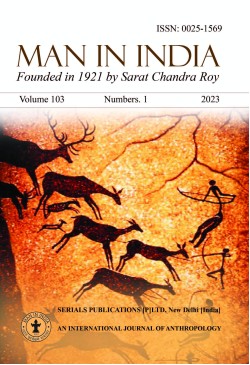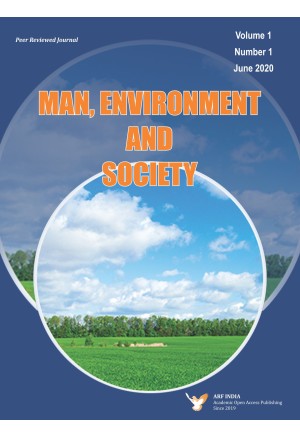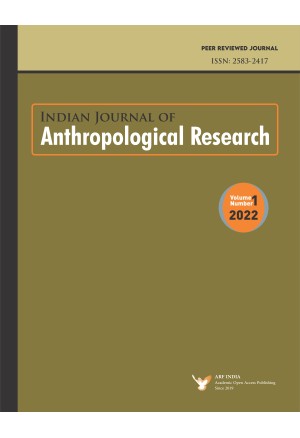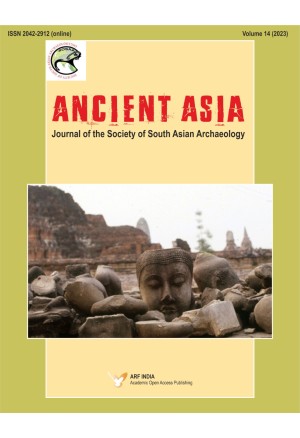MAKE MOST OF THE KNOWLEDGE NETWORK, JOIN ACADEMIC RESEARCH FOUNDATION
Latest Articles :- Vol: (104) (1-2) (Year:2024)
MISRECOGNIZED IDENTITIES: AN ANTHROPOLOGICAL INVESTIGATION OF THE IDENTITY STRUGGLE OF DE-NOTIFIED, NOMADIC AND SEMI-NOMADIC COMMUNITIES OF INDIA
BY: Ranjan Chatterjee, Sayantani Kundu, Utkarsh Srivastava, Koel MukherjeeMan in India, Year:2024, Vol.104 (1-2), PP.1-23
| Publication: 26 June 2024
DOI : https://DOI:10.47509/MII.2024.v104i01-2.01
India stands as a mosaic of diversity, its cultural heritage and intricate social fabric enhancing its complexity. Within this context, a distinct amalgamation of ethnic groups, each distinguished by culture, language, and traditions, finds its abode. However, this tapestry bears threads of fading identity and existential turmoil that intertwine with the De-notified, Nomadic, and Semi-nomadic communities. Hence, this research explores the critical factors surrounding the ethnic identity of these communities within India, simultaneously delving into the influence exerted by globalisation upon their livelihood practices and the anomalies in self-identity amid the diverse Indian milieu. The study is rooted in an investigation encompassing five communities: Dhara/Dhibar, Bansphor/Bansforda, Khurpalta, Muriari, and Savar. These communities are drawn from clusters in West Bengal, Jharkhand, Bihar, and Uttar Pradesh. Purposive and snowball sampling techniques were employed to identify and select the community members as participants, followed by the collection of data through numerous qualitative methods, including semi-structured interviews, observation, field notes, and focus group discussions. In addition, existing literature was undertaken to supplement existing knowledge through literary sources, governmental reports, and unpublished reports. The study’s findings illuminate how the erosion of traditional livelihood practices has propelled these communities to the verge of marginalisation, concurrently exacerbating the intricacies of their identity predicament in their daily life.
Keywords: de-notified; nomadic; ethnic identity; Indian communities; marginalised groups; intersectionality; social inclusion; social justice; identity struggle; livelihood
India stands as a mosaic of diversity, its cultural heritage and intricate social fabric enhancing its complexity. Within this context, a distinct amalgamation of ethnic groups, each distinguished by culture, language, and traditions, finds its abode. However, this tapestry bears threads of fading identity and existential turmoil that intertwine with the De-notified, Nomadic, and Semi-nomadic communities. Hence, this research explores the critical factors surrounding the ethnic identity of these communities within India, simultaneously delving into the influence exerted by globalisation upon their livelihood practices and the anomalies in self-identity amid the diverse Indian milieu. The study is rooted in an investigation encompassing five communities: Dhara/Dhibar, Bansphor/Bansforda, Khurpalta, Muriari, and Savar. These communities are drawn from clusters in West Bengal, Jharkhand, Bihar, and Uttar Pradesh. Purposive and snowball sampling techniques were employed to identify and select the community members as participants, followed by the collection of data through numerous qualitative methods, including semi-structured interviews, observation, field notes, and focus group discussions. In addition, existing literature was undertaken to supplement existing knowledge through literary sources, governmental reports, and unpublished reports. The study’s findings illuminate how the erosion of traditional livelihood practices has propelled these communities to the verge of marginalisation, concurrently exacerbating the intricacies of their identity predicament in their daily life.
Keywords: de-notified; nomadic; ethnic identity; Indian communities; marginalised groups; intersectionality; social inclusion; social justice; identity struggle; livelihood
CONCEPTUALIZATION OF HEALTH AND SEEKING BEHAVIOUR AMONG PENGU TRIBE IN VISAKHAPATNAM AGENCY OF ANDHRA PRADESH
BY: Srinivas Chetti, P.D. Satya Pal Kumar & D.RameshMan in India, Year:2024, Vol.104 (1-2), PP.25-39
| Publication: 26 June 2024
DOI : https://DOI:10.47509/MII.2024.v104i01-2.02
Societies perceive health in terms of disease and well-being, the health-seeking is regulated by varied practices in the fold of culture and environment. Health-seeking behaviour and practices vary across cultures due to diversities in the concept of health, socio-religious beliefs, and eco-cultural processes. The present study delineates the health-seeking behaviour among the Pengu tribe in Visakha Agency. The present study has been selected Eight Pengu villages representative and purposive sampling procedure and used participant observation, case study, FGDs, and in-depth interview methods. Pengu ethnic group has its own perspective and view of health and the healthcare system. The Pengu ethnic community thinks that illness is the consequence of supernatural phenomena, thereby carrying out prayers or performing ritual acts, which cure the illness and relieve them from pain. Four kinds of healthcare practitioners are seen in the study area. They are Disari, Gurmai, Pujari and Quacks. Accepting modern medical treatments and medication is at the initial stages of acceptance, but inaccessibility and unavailability of need and urgency are driving them back to native methods of healing.
Keywords: Illness, Seeking Behavior, Health, Pengu, Particular Vulnerable Tribal Group, Andhra Pradesh
Societies perceive health in terms of disease and well-being, the health-seeking is regulated by varied practices in the fold of culture and environment. Health-seeking behaviour and practices vary across cultures due to diversities in the concept of health, socio-religious beliefs, and eco-cultural processes. The present study delineates the health-seeking behaviour among the Pengu tribe in Visakha Agency. The present study has been selected Eight Pengu villages representative and purposive sampling procedure and used participant observation, case study, FGDs, and in-depth interview methods. Pengu ethnic group has its own perspective and view of health and the healthcare system. The Pengu ethnic community thinks that illness is the consequence of supernatural phenomena, thereby carrying out prayers or performing ritual acts, which cure the illness and relieve them from pain. Four kinds of healthcare practitioners are seen in the study area. They are Disari, Gurmai, Pujari and Quacks. Accepting modern medical treatments and medication is at the initial stages of acceptance, but inaccessibility and unavailability of need and urgency are driving them back to native methods of healing.
Keywords: Illness, Seeking Behavior, Health, Pengu, Particular Vulnerable Tribal Group, Andhra Pradesh
RECOGNIZING INDIGENOUS TRADITIONAL KNOWLEDGE WITH MEDICINAL VALUE WITHIN A LEGAL FRAMEWORK: AN OVERVIEW OF THE ISSUES AND CHALLENGES WITH SPECIAL FOCUS ON INDIA
BY: Suman Chakrabarty & Kamrul HossainMan in India, Year:2024, Vol.104 (1-2), PP.41-60
| Publication: 26 June 2024
DOI : https://DOI:10.47509/MII.2024.v104i01-2.03
Recognizing traditional knowledge with medical value among Indigenous people is indispensable to sustaining their way of life. However, legal complexities and challenges exist in recognizing the medical value of traditional knowledge, as it is orally transmitted and thus undocumented. While a global solution to such difficulties cannot employ a “one size fits all” approach and invokes multifaceted solutions within national regulatory and policy contexts, India has shown progress in this area. Yet, appropriate guidelines for incorporating the diverse medical knowledge of Indigenous people under a coherent framework must be developed so that Indigenous people can enjoy, and utilize, their rights regarding this knowledge. The objective was to unfold the current situation of traditional medicinal value among Indian Indigenous communities and find ways of recognizing this knowledge within India’s intellectual property rights (IPR) legal regime. The present study was based on secondary data sources. A specific literature review was done using the key word “Traditional Knowledge”, combined with “Intellectual Property Rights”, “Tribes”, “Medicinal Plant”, “Ethno-medicine”, “Folk Lore”, “Medical Anthropology”, “World Health Organization (WHO)”, “Traditional Knowledge Digital Library (TKDL)”, World Intellectual Property Organization (WIPO), “Patent Act”, “Illness and Sickness” and “India” on PubMed, Google Scholar and other relevant online and offline sources from March 2021 to September 2023. Our findings recommend a multi-tiered approach to documenting traditional medical knowledge, sensitive to regional diversities within India, as a necessary precursor to legal recognition. Therefore, a human rights approach, particularly from the viewpoint of cultural rights, could be a best fit both to recognize the traditional knowledge as a cultural right and to offer the community as the right holder of the knowledge. Hence, appropriate guidelines to that direction should be formulated for incorporating the dispersed traditional medical knowledge of Indigenous people under a coherent framework so that they can enjoy, and utilize, their rights to this knowledge especially in the diverse Indian context.
Keywords: Traditional knowledge, Tribes, Intellectual Property Rights, Medicinal Plant, WIPO, WHO, Act, India
Recognizing traditional knowledge with medical value among Indigenous people is indispensable to sustaining their way of life. However, legal complexities and challenges exist in recognizing the medical value of traditional knowledge, as it is orally transmitted and thus undocumented. While a global solution to such difficulties cannot employ a “one size fits all” approach and invokes multifaceted solutions within national regulatory and policy contexts, India has shown progress in this area. Yet, appropriate guidelines for incorporating the diverse medical knowledge of Indigenous people under a coherent framework must be developed so that Indigenous people can enjoy, and utilize, their rights regarding this knowledge. The objective was to unfold the current situation of traditional medicinal value among Indian Indigenous communities and find ways of recognizing this knowledge within India’s intellectual property rights (IPR) legal regime. The present study was based on secondary data sources. A specific literature review was done using the key word “Traditional Knowledge”, combined with “Intellectual Property Rights”, “Tribes”, “Medicinal Plant”, “Ethno-medicine”, “Folk Lore”, “Medical Anthropology”, “World Health Organization (WHO)”, “Traditional Knowledge Digital Library (TKDL)”, World Intellectual Property Organization (WIPO), “Patent Act”, “Illness and Sickness” and “India” on PubMed, Google Scholar and other relevant online and offline sources from March 2021 to September 2023. Our findings recommend a multi-tiered approach to documenting traditional medical knowledge, sensitive to regional diversities within India, as a necessary precursor to legal recognition. Therefore, a human rights approach, particularly from the viewpoint of cultural rights, could be a best fit both to recognize the traditional knowledge as a cultural right and to offer the community as the right holder of the knowledge. Hence, appropriate guidelines to that direction should be formulated for incorporating the dispersed traditional medical knowledge of Indigenous people under a coherent framework so that they can enjoy, and utilize, their rights to this knowledge especially in the diverse Indian context.
Keywords: Traditional knowledge, Tribes, Intellectual Property Rights, Medicinal Plant, WIPO, WHO, Act, India
THE PRACTICE OF TATTOOING: INSIGNIA, MEANING AND COMMUNICATION
BY: Ketaki DwivediMan in India, Year:2024, Vol.104 (1-2), PP.61-75
| Publication: 26 June 2024
DOI : https://DOI:10.47509/MII.2024.v104i01-2.04
The popular culture comprises of music, film, television, sports and fashion. As diverse a form of media as they may be, they all transmit and communicate meanings. While meanings are effectively communicated through spoken as well as written languages, they can also be conveyed through symbols, insignia, totems or emblems, engraved on body as tattoos. Tattoos are a form of art or design made on the skin, which changes its pigment. Tattoos engraved on body as symbols signify varied meanings. They speak to society or simply to the members, making social life replete with messages. Similar to text, tattoos convey stories that may relate to existential questions like genealogy, identity, status, achievement, medicine/therapy as well as ontological relations like ancestors, spirits and animals. Tattoos being an integral part of all the cultures played significant functions like medicinal, spiritual, social and semiotic. The understanding and perception of tattooing as a practice itself has undergone several changes over different time periods. Further, tattooing as a cultural practice has attracted the interest of Anthropologists, Sociologists and Psychologists. This work tries to understand provenance of tattooing as a cultural symbol in aboriginal/primitive as well as modern societies and culturally specific meanings attributed to them in both Indian as well as other contexts.
Keywords: Rites of passage, semiotics, subculture, sacred
The popular culture comprises of music, film, television, sports and fashion. As diverse a form of media as they may be, they all transmit and communicate meanings. While meanings are effectively communicated through spoken as well as written languages, they can also be conveyed through symbols, insignia, totems or emblems, engraved on body as tattoos. Tattoos are a form of art or design made on the skin, which changes its pigment. Tattoos engraved on body as symbols signify varied meanings. They speak to society or simply to the members, making social life replete with messages. Similar to text, tattoos convey stories that may relate to existential questions like genealogy, identity, status, achievement, medicine/therapy as well as ontological relations like ancestors, spirits and animals. Tattoos being an integral part of all the cultures played significant functions like medicinal, spiritual, social and semiotic. The understanding and perception of tattooing as a practice itself has undergone several changes over different time periods. Further, tattooing as a cultural practice has attracted the interest of Anthropologists, Sociologists and Psychologists. This work tries to understand provenance of tattooing as a cultural symbol in aboriginal/primitive as well as modern societies and culturally specific meanings attributed to them in both Indian as well as other contexts.
Keywords: Rites of passage, semiotics, subculture, sacred
BABASAHEB DR. B.R. AMBEDKAR’S HUMAN RIGHTS MOVEMENT AND CONTEMPORARY ISSUES IN SOCIO-ECONOMIC AND SOCIO-POLITICAL UPLIFTMENT OF THE DEPRESSED SECTIONS IN INDIA
BY: Debashis DebnathMan in India, Year:2024, Vol.104 (1-2), PP.77-92
| Publication: 26 June 2024
DOI : https://DOI:10.47509/MII.2024.v104i01-2.05
Dr. B.R. Ambedkar is a great thinker, academician, philosopher, lawyer, and renowned intellectual who took up leadership for the upliftment of the depressed, underprivileged and marginalized classes in society, securing human rights through various movements in social, educational, economic, and political realms. Dr. Ambedkar’s comprehensive efforts spanned social, economic, political, educational, intellectual, women’s rights, religious, and labor movements, highlighting his dedication to addressing the challenges faced by these communities. It also underscores his role as a scholar, activist, and architect of the Indian Constitution, emphasizing his principles of liberty, equality, fraternity, and social justice. Furthermore, it discusses the root cause of inequalities in India as caste-based, with Dr. Ambedkar identifying Brahmanism and Capitalism as enemies of humanity. His significant contributions to economic thought, including land reforms, industrialization, and the role of the state in economic planning and development, are highlighted. Additionally, the paper emphasizes his emphasis on the importance of education in empowering marginalized communities and his efforts to secure equal status for women in Indian society. Furthermore, it outlines his legal activism, proposals for legal reforms, and his memorandum to the Constituent Assembly, which aimed at establishing social democracy and state socialism. His unwavering commitment to advocating for the rights of Dalits and other marginalized communities through legal means is also highlighted, along with his struggle for separate electorate and the Hindu Code Bill for the protection and development of Hindu women. The paper concludes with a call for further research into the economic conditions of these communities, their political ideologies, and the governmental and organizational efforts to enhance their self-employment opportunities and overall progress.
Keywords: Depressed, Human rights, social reforms, educational upliftment, economic reconstruction, political movements
Dr. B.R. Ambedkar is a great thinker, academician, philosopher, lawyer, and renowned intellectual who took up leadership for the upliftment of the depressed, underprivileged and marginalized classes in society, securing human rights through various movements in social, educational, economic, and political realms. Dr. Ambedkar’s comprehensive efforts spanned social, economic, political, educational, intellectual, women’s rights, religious, and labor movements, highlighting his dedication to addressing the challenges faced by these communities. It also underscores his role as a scholar, activist, and architect of the Indian Constitution, emphasizing his principles of liberty, equality, fraternity, and social justice. Furthermore, it discusses the root cause of inequalities in India as caste-based, with Dr. Ambedkar identifying Brahmanism and Capitalism as enemies of humanity. His significant contributions to economic thought, including land reforms, industrialization, and the role of the state in economic planning and development, are highlighted. Additionally, the paper emphasizes his emphasis on the importance of education in empowering marginalized communities and his efforts to secure equal status for women in Indian society. Furthermore, it outlines his legal activism, proposals for legal reforms, and his memorandum to the Constituent Assembly, which aimed at establishing social democracy and state socialism. His unwavering commitment to advocating for the rights of Dalits and other marginalized communities through legal means is also highlighted, along with his struggle for separate electorate and the Hindu Code Bill for the protection and development of Hindu women. The paper concludes with a call for further research into the economic conditions of these communities, their political ideologies, and the governmental and organizational efforts to enhance their self-employment opportunities and overall progress.
Keywords: Depressed, Human rights, social reforms, educational upliftment, economic reconstruction, political movements
STIGMAS ARE STILL THERE: COLONIAL STEREOTYPE BEHIND BUDHAN SABAR'S DEATH
BY: Gourab DasguptaMan in India, Year:2024, Vol.104 (1-2), PP.93-117
| Publication: 26 June 2024
DOI : https://DOI:10.47509/MII.2024.v104i01-2.06
After a long two and a half decades, when Budhan became a symbol of movement, the conclusive verdict in the Budhan Sabar death case was delivered in February 2023, in which he died in jail custody following an illegal detention by the local police authority. Budhan was a member of the Kheriya-Sabar Tribe, an Ex-D.N.T. in the Purulia district, which was formerly known as the Criminal Tribes and was officially used after the introduction of the Criminal Tribes Act in 1871. The British capitalised on colonial legislative authority to stigmatise such class and tribal identities in order to control and wipe them out from any passive or active struggle in the remaining phases of their reign; however, these stigmatic feelings of exhaustion and dearth of confidence long persisted among these marginalised tribes of India for decades after independence. The present study illuminates the connection between colonial stereotypes and the Budhan Sabar case in Historical point of view.
Keywords: Budhan Sabar, Criminal Tribe Act, Police brutality, Stereotype, Stigma.
After a long two and a half decades, when Budhan became a symbol of movement, the conclusive verdict in the Budhan Sabar death case was delivered in February 2023, in which he died in jail custody following an illegal detention by the local police authority. Budhan was a member of the Kheriya-Sabar Tribe, an Ex-D.N.T. in the Purulia district, which was formerly known as the Criminal Tribes and was officially used after the introduction of the Criminal Tribes Act in 1871. The British capitalised on colonial legislative authority to stigmatise such class and tribal identities in order to control and wipe them out from any passive or active struggle in the remaining phases of their reign; however, these stigmatic feelings of exhaustion and dearth of confidence long persisted among these marginalised tribes of India for decades after independence. The present study illuminates the connection between colonial stereotypes and the Budhan Sabar case in Historical point of view.
Keywords: Budhan Sabar, Criminal Tribe Act, Police brutality, Stereotype, Stigma.
RESISTANCE AND RETALIATION OF CASTE-BASED VIOLENCE AND ASSERTION: EVIDENCES FROM ODISHA STATE
BY: Jayashree AmbewadikarMan in India, Year:2024, Vol.104 (1-2), PP.119-130
| Publication: 26 June 2024
DOI : https://DOI:10.47509/MII.2024.v104i01-2.07
Even after 75 years of Indian freedom, the ascriptive nature of caste resistance has not been able to totally outlaw the empirical separatist practices of segregation, untouchability, and caste discrimination. Over 200 million people in India are classified as “Untouchables,” a group stained by birth who are placed under the Hindu caste system, which regards them as impure and less than human. The practice of “untouchability” is a form of social discrimination that is prevalent in many parts of India, particularly in rural areas. Despite the constitutional abolition of “untouchability” in India under Article 17, the practice still pervades society, particularly towards the lower castes. Among these castes, the Dalits face a particularly harsh reality. Caste-based violence is byproduct of a centuries-old custom. This inequality has far-reaching consequences for the Dalits, hindering their ability to legitimize their claims to access education, employment, housing, religious rights and all basic human rights, dignity and respect. This paper looks into the issue of the above said violence with conceptual understanding with qualitative approach through case study method and focus group discussions for understanding resistance and retaliation of caste based violence and assertion in the state of Odisha, Kendrapara district.
Keywords: Caste-based violence, dalits, human rights, gender, Odisha
Even after 75 years of Indian freedom, the ascriptive nature of caste resistance has not been able to totally outlaw the empirical separatist practices of segregation, untouchability, and caste discrimination. Over 200 million people in India are classified as “Untouchables,” a group stained by birth who are placed under the Hindu caste system, which regards them as impure and less than human. The practice of “untouchability” is a form of social discrimination that is prevalent in many parts of India, particularly in rural areas. Despite the constitutional abolition of “untouchability” in India under Article 17, the practice still pervades society, particularly towards the lower castes. Among these castes, the Dalits face a particularly harsh reality. Caste-based violence is byproduct of a centuries-old custom. This inequality has far-reaching consequences for the Dalits, hindering their ability to legitimize their claims to access education, employment, housing, religious rights and all basic human rights, dignity and respect. This paper looks into the issue of the above said violence with conceptual understanding with qualitative approach through case study method and focus group discussions for understanding resistance and retaliation of caste based violence and assertion in the state of Odisha, Kendrapara district.
Keywords: Caste-based violence, dalits, human rights, gender, Odisha
IN THE MEMORY OF PROFESSOR DR. SERGEY A. ARUTYNOV
(July 1, 1932 — December 21, 2023)
BY: Dr. Svetlana RyzhakovaMan in India, Year:2024, Vol.104 (1-2), PP.131-137
| Publication: 26 June 2024
DOI : https://DOI:10.47509/MII.2024.v104i01-2.08
TRAINS FROM BANGLADESH: TRANSNATIONALISM AND FESTIVAL AMONG THE MUSLIMS OF MIDNAPORE TOWN IN WEST BENGAL
BY: Mukhreja KhatunMan in India, Year:2024, Vol.104 (1-2), PP.139-149
| Publication: 26 June 2024
DOI : https://DOI:10.47509/MII.2024.v104i01-2.09
The annual Urs festival, celebrated at the Mazar in the town of Midnapore, West Bengal, is the most significant regional Muslim event. Although the festival is a regional event, yet the celebration is attended by people from outside the state and the country at the Pir's Urs festival at Jora masjid Mazar. The Urs festival is also celebrated in other Mazars to commemorate the death anniversaries of different Pirs. The researcher collected data using participant observation and interview methods to study the Urs festival in the Mazar. The main aim of this study is to documnet the events held during festival and to understand the maintenance of cross-border relationships between two countries through transnational movements in the Urs festival at Jora masjid specifically focusing on the impact of cross-border pilgrimage. This Urs festival, with its regional origins, attracts participants from various regions and even from other countries, highlighting its global importance. This event commemorates the death anniversary of a respected Pir in the town and draws followers from diverse geographical areas, emphasizing its international appeal. However, information on the other Urs festivals in the town has also been provided here.
Keywords: Mazar, Urs, Muslim, Transnationalism, Impact.
The annual Urs festival, celebrated at the Mazar in the town of Midnapore, West Bengal, is the most significant regional Muslim event. Although the festival is a regional event, yet the celebration is attended by people from outside the state and the country at the Pir's Urs festival at Jora masjid Mazar. The Urs festival is also celebrated in other Mazars to commemorate the death anniversaries of different Pirs. The researcher collected data using participant observation and interview methods to study the Urs festival in the Mazar. The main aim of this study is to documnet the events held during festival and to understand the maintenance of cross-border relationships between two countries through transnational movements in the Urs festival at Jora masjid specifically focusing on the impact of cross-border pilgrimage. This Urs festival, with its regional origins, attracts participants from various regions and even from other countries, highlighting its global importance. This event commemorates the death anniversary of a respected Pir in the town and draws followers from diverse geographical areas, emphasizing its international appeal. However, information on the other Urs festivals in the town has also been provided here.
Keywords: Mazar, Urs, Muslim, Transnationalism, Impact.
BOOK REVIEW



-300x438.jpg)

